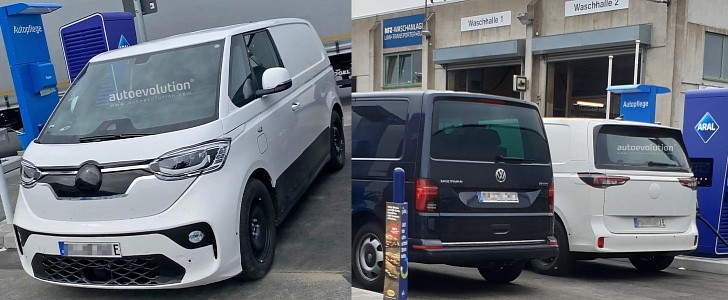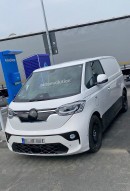In the wake of the Dieselgate scandal, Volkswagen doubled down on electric vehicles. Billions of dollars were poured into the brand-new MEB vehicle architecture, and so far, the bet has worked perfectly for VW.
Volkswagen puts the modular electric platform on a pedestal so high that the Modularer E-Antriebs-Baukasten has been described as the automaker’s third revolutionary spark of genius after the air-cooled Beetle and the Golf.
At the present moment, Volkswagen offers no fewer than seven nameplates on this all-encompassing vehicle architecture, starting with the well-known ID.3 hatchback and ID.4 crossover. The remainder of the list consists of the ID.6, the Skoda Enyaq, Cupra Born, and the Audi Q4 in two body options.
Fast and cost-effective scalability is the name of the game, and Volkswagen knows that greater profits are to be made if the MEB is applied to the light commercial vehicle segment. That brings us to the ID.Buzz, a Microbus revival previewed four years ago at the 2017 North American Auto Show.
Spied on multiple occasions with body panels from the T6, the passenger-oriented van has been finally captured with production-spec clothes by the carparazzi next to a blue-painted Multivan. The prototype still features tons of camouflage, but nevertheless, you can tell how different the ID.Buzz is from the long-lived Transporter series introduced by Volkswagen in 1950.
The aero-focused front is most intriguing partly because the windshield features a forward-facing camera in the lower part of the glass where the windshield meets the dashboard. A lone charging port is featured on the driver-side front fender, which is—dare I say it—the perfect location because the driver can unload or load any cargo while the panel van is being charged.
The rear end is just as boxy as the Multivan 4Motion next to the ID.Buzz, save for the integrated rear spoiler that flanks three sides of the rear window. Speaking of 4Motion, the work-oriented variants and passenger-carrying models will feature rear-wheel drive as standard plus a dual-motor option.
The concept mentioned earlier rocks a 111-kWh battery, 369 horsepower, and ranges of 600 kilometers on the NEDC or 270 miles as per current U.S. regulations. By comparison, the current crop of MEB electric vehicles tops 82 kWh with a usable capacity of 77 kWh, 295 horsepower, and up to 550 kilometers of WLTP range or 260 miles for the United States market.
At the present moment, Volkswagen offers no fewer than seven nameplates on this all-encompassing vehicle architecture, starting with the well-known ID.3 hatchback and ID.4 crossover. The remainder of the list consists of the ID.6, the Skoda Enyaq, Cupra Born, and the Audi Q4 in two body options.
Fast and cost-effective scalability is the name of the game, and Volkswagen knows that greater profits are to be made if the MEB is applied to the light commercial vehicle segment. That brings us to the ID.Buzz, a Microbus revival previewed four years ago at the 2017 North American Auto Show.
Spied on multiple occasions with body panels from the T6, the passenger-oriented van has been finally captured with production-spec clothes by the carparazzi next to a blue-painted Multivan. The prototype still features tons of camouflage, but nevertheless, you can tell how different the ID.Buzz is from the long-lived Transporter series introduced by Volkswagen in 1950.
The aero-focused front is most intriguing partly because the windshield features a forward-facing camera in the lower part of the glass where the windshield meets the dashboard. A lone charging port is featured on the driver-side front fender, which is—dare I say it—the perfect location because the driver can unload or load any cargo while the panel van is being charged.
The rear end is just as boxy as the Multivan 4Motion next to the ID.Buzz, save for the integrated rear spoiler that flanks three sides of the rear window. Speaking of 4Motion, the work-oriented variants and passenger-carrying models will feature rear-wheel drive as standard plus a dual-motor option.
The concept mentioned earlier rocks a 111-kWh battery, 369 horsepower, and ranges of 600 kilometers on the NEDC or 270 miles as per current U.S. regulations. By comparison, the current crop of MEB electric vehicles tops 82 kWh with a usable capacity of 77 kWh, 295 horsepower, and up to 550 kilometers of WLTP range or 260 miles for the United States market.













